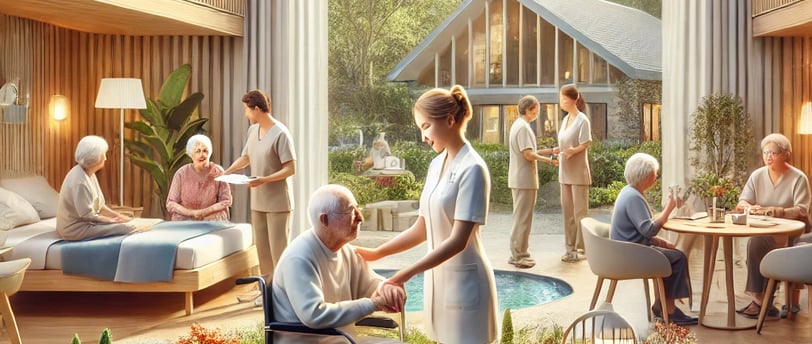Marketing Strategy for Nursing Homes: Challenges, Solutions and Best Practices
Find out how to develop a marketing strategy for nursing homes. Concrete solutions, examples in France and Europe, and advice to meet the expectations of residents, families and caregivers.
VEILLE SOCIALEVEILLE ECONOMIQUEMANAGEMENTRSEMARKETING
Lydie GOYENETCHE
1/5/20253 min read


EHPADs (Residential Establishments for Dependent Elderly People) face complex challenges that require an adapted marketing strategy.
Between the growing expectations of residents, the demands of families and the need for innovation, these establishments must adapt to meet the changes in society. Inspired by good practices observed in France and elsewhere in Europe, concrete avenues are emerging to meet these challenges.
Restoring a weakened reputation
In recent years, several scandals have tarnished the image of nursing homes, including the Orpea affair in France, which revealed serious shortcomings in management and care. This crisis has highlighted the importance of transparent and proactive communication. For example, some nursing homes of the LNA Santé group publish regular reports on the quality of services and the feedback from families. In Sweden, facilities are using interactive platforms that allow relatives to follow residents' care and activities in real time. These initiatives help to restore trust and demonstrate a genuine commitment to residents.
Repairing ties with families after Covid-19
The pandemic has profoundly affected the relationship between nursing homes and families. In 2020, three out of four facilities restricted or banned visits, causing residents to feel isolated and their loved ones to be very frustrated. To ease this tension, innovative initiatives have emerged. In France, some establishments such as those of the Colisée group have set up spaces dedicated to visits in complete safety, even in times of health restrictions. In Italy, "cuddle rooms" have allowed residents and their families to meet in complete serenity thanks to flexible protective curtains. These measures show that it is possible to maintain the link, even in constrained contexts.
Reconciling individuality and collective life
Entering a nursing home often involves adapting to a collective rhythm, which can lead to a loss of individuality for residents, especially those with mobility difficulties. In France, some establishments such as those of the Partage et Vie foundation organize weekly outings to allow residents to regain a little autonomy, such as going shopping or visiting a cultural place. In Germany, the "Seniorenbus" program makes it easier for residents to travel individually for personal activities, thus strengthening their sense of freedom. Such initiatives show that it is possible to reconcile collective life and individual needs.
Meeting the expectations of new seniors
Today's seniors want more than just a medical setting. They aspire to an enriching social and cultural life. Some French nursing homes, such as those of the Korian group, offer writing workshops, intergenerational activities and musical events. In Norway, facilities have incorporated participatory vegetable gardens and animal spaces where residents can interact with animals, improving their well-being. These initiatives illustrate the need for an approach that focuses on the personal development of residents.
Increasing visibility through digital technology
With the omnipresence of the internet in the search process, an effective digital presence has become essential. In France, groups such as DomusVi offer virtual tours of their establishments, allowing families to discover places and services remotely. In Spain, some nursing homes use social networks to share moments of life, thus humanizing their image and reassuring families. Proactive management of online reviews is also essential for building a positive online reputation and attracting new residents.
Attracting and retaining healthcare staff
The shortage of staff in nursing homes is a recurring problem. In response, some French institutions are setting up mentoring and continuing education programs to promote careers in geriatrics. In Belgium, nursing homes such as those of the Armonea group offer flexible hours and opportunities for development, making these positions more attractive. These efforts help to improve not only the attractiveness of the staff, but also the quality of care for the residents.
Committing to a CSR approach
Families and residents are increasingly sensitive to responsible initiatives. In France, the ACPPA group is promoting local partnerships for food supply, while in Sweden, nursing homes are adopting policies to reduce food waste by integrating composting solutions and optimized menus. These approaches strengthen the image of the establishments and appeal to a public that is more concerned about environmental issues.
Conclusion: A forward-looking marketing strategy
A marketing strategy for nursing homes must go beyond simple communication and integrate concrete actions that meet the expectations of residents, families and staff. By drawing inspiration from best practices in France and Europe, nursing homes can restore their image and reposition themselves as places of life where human quality and innovation occupy a central place. With an approach combining transparency, individualization and societal commitment, institutions can meet the challenges of a sector in full transformation while meeting the expectations of current and future generations.


EUSKAL CONSEIL
9 rue Iguzki alde
64310 ST PEE SUR NIVELLE
FRANCE
0033782505766
euskalconseil@gmail.com

